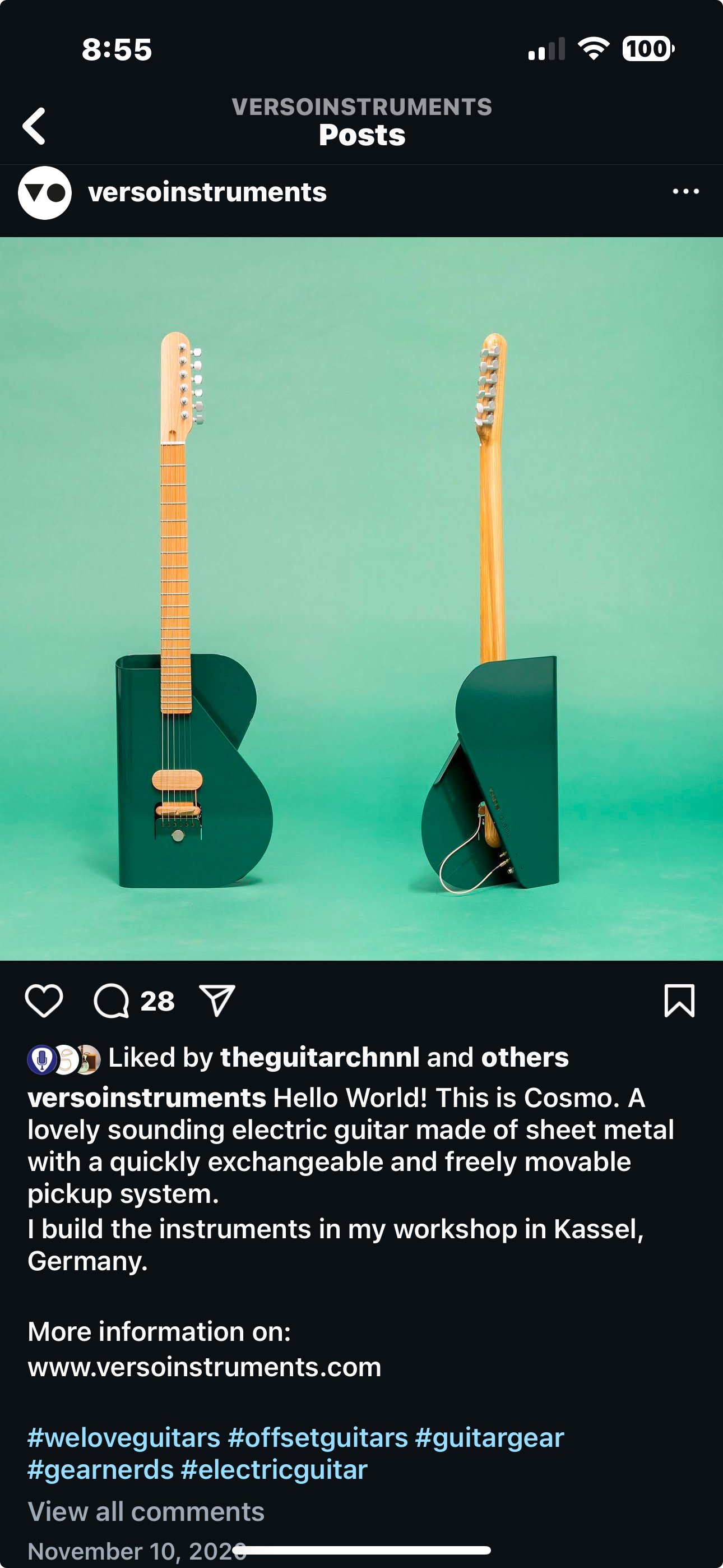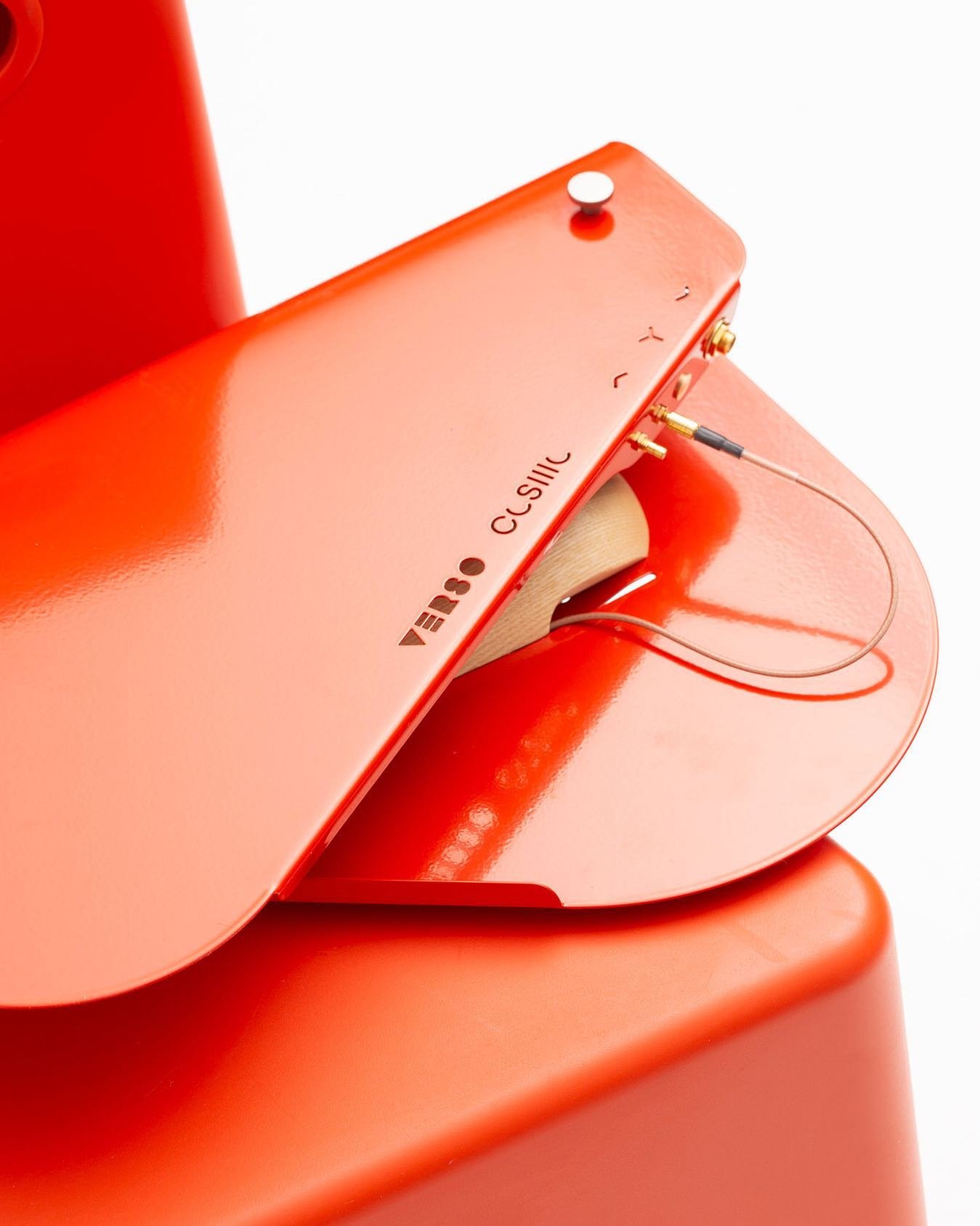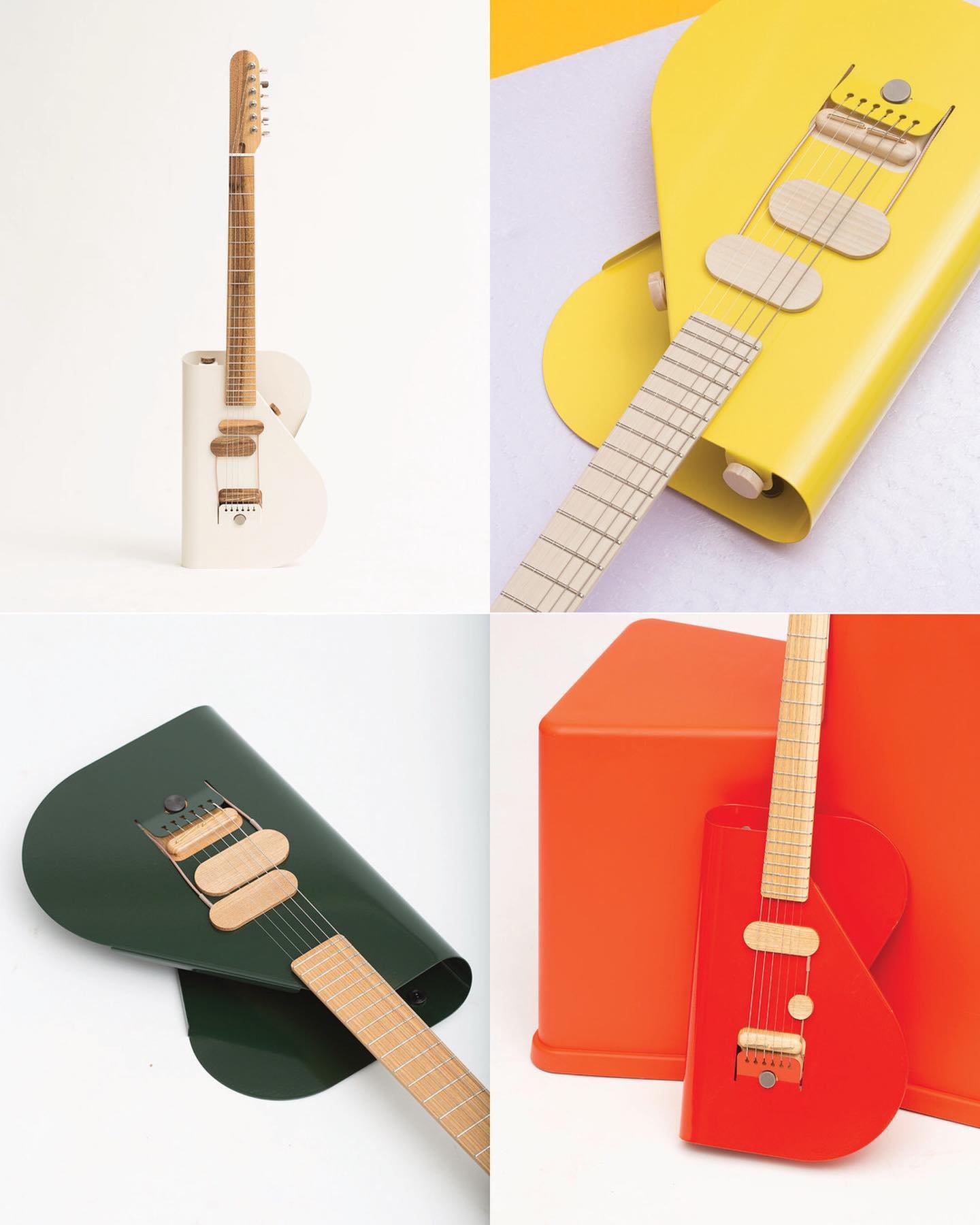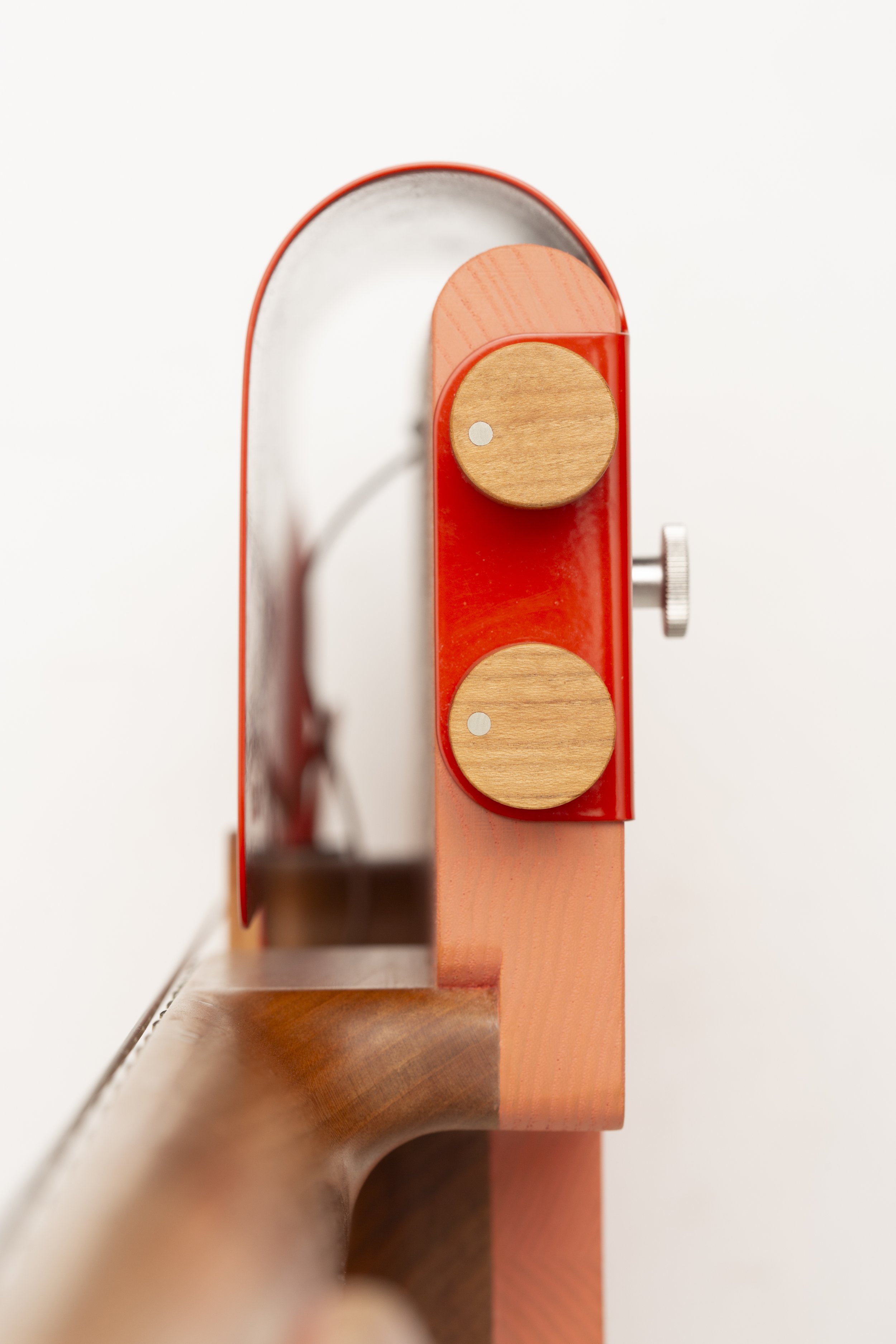Image: Sine | Verso Instruments | Photo: Robin StummvollA Playful approach to Guitar Design
By Jamie Gale | Curator
Boutique Guitar Showcase
It’s not often that a new guitar catches the imagination of the entire global community of creative guitar makers, but that’s what happened when Robin Stummvoll presented to the world his first guitar design; Cosmo, by Verso Instruments.
I didn’t count how many times I received messages from people excited to share this wondrous new design, but I can confidently say that it was more messages about any one guitar than I have ever received before or since.
For a man who has made his career showcasing the world's most Unique, World-Class Guitars, it was obvious to everyone that Jamie Gale should know about this remarkable new design, that seems to have sprung fully formed from the head of Zeus.
Why didn’t we see it coming? Because Robin Stummvoll is not a Luthier, he’s an industrial designer. He didn’t spend years learning the Luthier traditions, creating replicas from the Luthier’s canon, Stradivarius, Torres, Martin, Fender, etc. We didn’t meet in one of the Luthier schools throughout Europe or North America where I teach every year. Nor did he attend one of the many guitar shows where luthiers bring their first instruments and display them on a table, in a row of tables, alongside their peers. In fact, nobody in the guitar community had ever met him or seen his work until the first picture surfaced on Instagram on November 10, 2020, with a friendly, but provocative post that simply said
“Hello World! This is Cosmo. A lovely sounding electric guitar made of sheet metal with a quickly exchangeable and freely movable pickup system.”
A folded piece of sheet metal in bold, yet playful colours. Very simple, very clever.
The communication was clear. The images beautiful and friendly. The videos clean and effective. The graphics, typefaces and colour pallet so well considered… Was this a corporation? How do they have it so together, so right, from the very beginning?
Well…the beginning is indeed the first clue. Stummvoll was born to a Mother who was a marketing professional. His Father, Artist and Painter. Even his two siblings are professional Photographers and Illustrators. His family home was a fertile ground for the production of creative works. Today Robin sees his past as an unusually straight line to where he is today…and I would agree.
Robin Stummvoll | Industrial Designer, Founder, Verso InstrumentsGuitar entered his life at the age of six, the flame burning evermore. Performing music with friends and bandmates until the present day. The guitar is woven into the fabric of his life.
By sixteen he was working professionally as a graphic designer. After a few years of working in the digital realm, it became clear to him that he wanted to work in the physical world, not just on screens. In the world of design, this means going from Graphic to Industrial design.
I think the term Industrial design often misleads people to think that this field of work is very technical, like engineering or architecture, and though it is, the main point of a design education is about thinking. How to think, not what to think. How to consider a problem or idea. A close friend of mine once told me that the design firm where he works’ guiding principle is “Good design is well considered”, and they’re right.
Original sketch of Cosmo conceptThe Industrial Designers I know, are all extremely logical, and calm. They are some of the most pleasant people I know. This comes from understanding exactly why you are doing something, what is reasonable to expect, that failure is a necessary part of the creative process, and that curiosity and play are their biggest assets.
I recently heard a neuroscientist explain that the part of the brain that regulates Anxiety (uncertainty) is the same part of the brain that regulates Curiosity and Exploration.
Curiosity and exploration are the trained super-power of designers because when resolved, you arrive at Certainty, the antithesis of anxiety.
Perhaps they do the work to resolve the parts of a design that would cause anxiety in any of us so that when the work is complete, we are much more likely to accept it because they’ve already explored and resolved problems.
Causal or correlated…not enough time to explore that in depth here. Regardless, Robin Stummvoll’s Verso Instruments - Cosmo, delighted the musically curious from the moment it first entered the world. Featured in Guitar publications, Wired, Architectural Digest, and of course, the NAMM Show’s Boutique Guitar Showcase.
Other iterations shortly followed. Bass, Baritone, New pickup configuration, and a plethora of colours. Accumulating more than a one-year back-order within the first 14 months of release, and ever since.
The overwhelming success of a first release meant that Stummvoll is now a Guitar Maker. What started as his final project to complete his industrial design degree has swept him away into the guitar business…for which he is very grateful.
Four years later, I am writing this on the eve of the release of his equally playful second design, Sine.
Sine evolved from the observation of Cosmo’s sheet metal Body’s ability to flex and return to zero. Zero being the stable point that the sheet metal’s material memory insists it return to. Because Verso Instruments pickups magnetically adhere to the sheet metal body, the pickup will travel with the body surface…should the surface be able to be distanced from the guitar strings, you would have another point of expression… let the PLAY begin!
Expression, led to further exploration when Stummvoll playfully considered using this new point of expression as a DAW (Digital Audio Workstation) or MIDI (Musical Instrument Digital Interface). Fortunately for him, he has friends at Lehle, A German signal routing solutions company, who make the highest quality magnetic signal sensing technology AND were interested in exploring Verso’s new Sine Pad for guitar expression. The results were marvellous, and a collaboration was formed.
Now you can get an analogue Sine, where the effects are made by flexing the Sine Pad to distance the pickups from the strings, or a second version with the Lehle upgrade allowing you to use the Sine Pad as a controller for a MIDI or DAW interface.
Interestingly, the Sine Pad, in guitar switching language is momentary, because of the previously mentioned automatic zero return of its spring form sheet metal. So effects are either full off until the Sine Pad is depressed, or fully on in resting position, being reduced only when depressing the Sine Pad. An interesting design limitation which is bound to force some unexpected creative results. Which makes it even more exciting…for those who like to explore new possibilities.
What will the traditional guitarists think of this new curiosity? They’ll likely play songs from their established hymnal, and judge it by how much it sounds like the already famous guitars in their heads, or does not sound like the famous guitars in their head. But as Doc Brown once famously said to Marty McFly “Roads? Where we’re going, we don’t need roads.”
Perhaps one day a Verso will be normal, and the Sine pad will be as ubiquitous as the Tremolo. All guitar players will know about it, and be able to instantaneously recall famous songs featuring Verso Sine guitars, and people will wear T-shirts of Dream Guitars featuring a Verso enshrined along with the other godly guitars complete with their saints and acolytes.
Either way, I am thankful for Robin Stummvoll’s curiosity and exploration. His willingness to fail along the way, and for reminding me that we PLAY guitar.










